
Fulton Beer, unassumingly tucked in a two-car garage behind a bungalow in a South Minneapolis neighborhood bearing the same name, is easily the embodiment of a home brewer’s dream come true.
The brainchild of a carpenter, lawyer, MBA student, and medical device researcher who characterize themselves as “the Village People of brewing, but much less musically inclined,” the long-time friends have spent years perfecting their homebrew creations on relatively simple equipment. Recently, they’ve logged many hours on the road between Minneapolis and the Sand Creek brewery in Wisconsin where they contract brew their ales on a commercial scale.
Fulton’s inaugural beer, a generously hopped yet balanced IPA called Sweet Child of Vine, has made more than a few positive ripples in the Twin Cities beer community since its launch in October. The brewery is decidedly focused on brewing “approachable” beers easy enough for craft beer novices to enjoy while offering the complexity and nuance demanded by hardcore aficionados. However, the group wants to be known for more than just its beer.
With aspirations including strong community involvement, sustainability, and an innovative program (aptly named Ful-10) designed to help other startups get the financial backing they need to get off the ground, Fulton is attempting to paint a slightly different picture than your average brewery.

We caught up with Peter Grande, Jim Diley, Brian Hoffman, and Ryan Petz (pictured above from left to right) of Fulton on a bitterly cold evening as they prepared to make another brewing run to Wisconsin, and discussed their company, brewing philosophies, and whether starting Fulton Bakery might serve as a potential backup strategy.
AARON MASTERSON: How did you guys meet and get started as a company?
RYAN PETZ: Brian, Jim, and I all went to St. John’s University and graduated in 2005, and we got started brewing around the same time. Not long after, Peter married Jim’s sister, so, that makes the four of us.
PETER GRANDE: July 23, 2005 to be exact. [laughter]
BRIAN HOFFMAN: Yeah, we started brewing about a year before we graduated, and Jim’s then-girlfriend (now wife) bought him a Mr. Beer Kit just as a fun, one-time thing. And that obviously turned into a slippery slope.
PETZ: Next thing she knew, we were brewing in her basement, and eventually out to her garage, which was one of those typical alley garages you always find in South Minneapolis. First time we ever brewed it was 20 below, and that was during the day. We were trying to keep the garage door closed as much as possible because it was so cold, but you have to have a little ventilation of course, so tons of steam was billowing out from the crack under the garage door.
GRANDE: The four of us were huddled around the turkey burner just trying to stay warm, but we’re all thinking, “Man, this is awesome! We’re making beer!”
PETZ: Then we ended up moving over here to Pete’s garage after our equipment overtook the space.
MASTERSON: So when you first started, what kinds of beers were you making? What styles or recipes did you gravitate to?
PETZ: Our first recipes we came up with were extract beers. We made a pilsner and an Oktoberfest. Or actually, you and Jim made one even before that…
GRANDE: Well, the first one Jim and I did together was actually a Sierra Nevada clone, and Jim didn’t really need me to help him brew it, he just wanted me to help cut the top off the keg and drill some holes. But I ended up brewing with him that day, and it actually turned out awesome, so I was hooked after that. But there actually was an ESB prior to that where we used Jim’s mom’s five-gallon enamel pot, and we made a whole sticky mess in the kitchen. So after that, if we wanted to brew we needed to get our own kettle and turkey burner out in the back.
MASTERSON: At what point did you guys look at each other and say, “We need to take this to the next level and start a company”? What was that conversation like?
GRANDE: Probably the first time we tried one of our beers that was actually halfway decent. [laughter]
PETZ: I mean, every home brewer kind of has that dream, and thinks, “Heck, this is good enough to sell.” But that was a long time before it actually became a business. We kept up those talks for a long time, and it had always been kind of a distant goal for us, but then we got more serious about it really just in the past year. We started working at it last spring, founded the company in June, and had our first sales in October.

MASTERSON: What are your backgrounds?
HOFFMAN: I was a biology major and I now do research for Boston Scientific, specifically heart failure, pacemakers, defibrillators, that kind of thing. My focus in college was more on plants, so that’s at least somewhat transferable to what we’re doing now.
GRANDE: I’m a carpenter…
PETZ: … not to mention a plumber, an electrician, a welder, and, well, you name it.
MASTERSON: So a pretty good guy to have around starting a brewery?
PETZ: Yes, Pete is definitely the mind behind actually making our brew house work. We kind of break it and he kind of fixes it. Speaking of which — Pete, I tried to turn it on today and light it, but something happened and we suddenly have no power.
GRANDE: So you broke it?
PETZ: Yes, I broke it again, in other words. [laughter] Anyhow, Jim is an attorney, and I am an MBA student right now at the U of M. So a lot of different fronts covered.
MASTERSON: Tell me about your launch party in October… What was it like watching total strangers drink your first-ever commercial beer?
PETZ: Our launch party was at The Happy Gnome on October 28th, and then immediately following that we were available at Stub & Herbs, Acadia, Bryant Lake Bowl, Edina Grill, Three Squares, and The Muddy Pig.
GRANDE: Actually, I really enjoyed buying one of my own beers! I walked up to the bar and ordered a Sweet Child, and they asked if it was on the distributor’s tab and I said, “Nope, I’m gonna pay for that.”
PETZ: The novelty wears off quickly, though. It is cool, but at the same time you think, “Man, if I buy four of these then we’re gonna lose money on this entire keg.” [laughter]
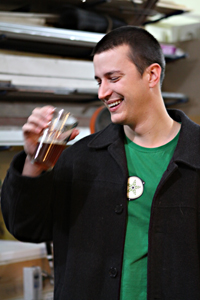
HOFFMAN: It was pretty surreal… The drive to the bar was a little nerve-wracking with all of the gear in the trunk, and I’m thinking, “Oh man, I haven’t tasted it in a few days; is it as good as I remember? Are people gonna like it? Are we the only ones that like it and all of our family and friends are just lying to us?” [laughter]
PETZ: It’s tough sometimes, because everyone who knows you is going to say it’s good, and they’ll probably mean it, but they’re not necessarily objective observers. For the launch event, we thought we’d have a good turnout because between the four of us we have a lot of family and friends around here, and everyone was pretty excited and had been following us through this process. But we didn’t anticipate how good the response was going to be. We went through 10 kegs of beer that night, and The Happy Gnome said they’d never had a beer launch event quite like that before. So it definitely exceeded our expectations.
MASTERSON: How many locations are carrying you?
PETZ: We’re up to 23 right now, I believe, and adding a few every week. Mainly in the Twin Cities but as far down as Hastings.
MASTERSON: Do you foresee expanding beyond the metro, or the state, down the road?
PETZ: In time we’d love to. The nice thing is, the people in the Twin Cities are really excited about craft beer right now and everyday we get emails from different bars and restaurants that want to carry us and people are asking for bottles. The local market has been so supportive that we want to continue to just grow here until we can get ahead of our production a little bit. But yeah, we’d eventually like to look at places in greater Minnesota and surrounding states.
MASTERSON: Do you plan to bottle at some point?
HOFFMAN: Yes, at some point which is yet to be determined. For the short term it’s just going to be on draught, but it’s one of those ongoing conversations.
PETZ: And part of it is we were very conservative and very much bootstrapping this when we started, and all of those things take money in investing in equipment, and we’ve had to choose very carefully what we do. So going on-premises on draught as a way to start made more sense, which means bottling will be a bit further down the road. We’re still trying to get a handle on making sure everything sells in our on-premises accounts, and we’re supporting the people who are supporting us. But then in time, once we get maybe two or three beers out, then we’ll certainly consider bottle sales too.
MASTERSON: So what’s different about Fulton? Do you see yourselves filling a particular niche in this market, or maybe offering a flavor profile that may not be represented right now?
PETZ: Philosophically, our slogan is “Ordinary Guys Brewing Extraordinary Beer.” There’s of course been a great explosion of microbreweries across the country, as well as here in Minnesota. But a lot of them are really trying to outdo one another with more extreme flavor profiles and more hops and higher alcohol content.
And those are all good things in their places, but we’re just trying to make beer that’s maybe more approachable to somebody that’s new to craft beer. We were new to craft beer once too, and we were pretty excited when we found out about it. We think we can create a balanced beer that can be approachable to somebody that’s new to craft beer, but also subtle and complex enough to somebody who is an enthusiast. So that’s really what we’re going for.
As far as styles, Sweet Child is an IPA, and we all know there’s a few IPAs out there. But at the same time, we don’t really feel like we’re competing with those other IPAs necessarily.
GRANDE: But that’s just our IPA at the moment… we’re still reserving the right to come out with some crazy stuff.
MASTERSON: So the next one you’re talking about is your imperial stout, Worthy Adversary?
PETZ: Yes, that’s right… and that beer is definitely one of those more extreme styles that comes in right around 10 percent ABV, is really rich, and has some dark, bitter grain flavors. But people that don’t even typically like stouts have told us they love it and they want more. So that’s kind of the cool thing, because we think you can make these beers but at the same time you don’t have to be a craft beer elitist or that experienced to enjoy it; anyone can approach it. I would say regardless of what beer we’re releasing, in general, they’re mostly going to be approachable.
We’re also looking at releasing our blonde ale this spring, and a lot of enthusiasts sort of turn up their noses at a blonde ale and think that’s the dumbed-down offering to appease the mass market. But we don’t look at it that way at all. It’s something we enjoy drinking a lot. It’s really only about 4.5% ABV and is definitely lighter, but has a nice grain bill and an interesting hop combination. So it does have that complexity, it’s not lacking in that way at all.
JIM DILEY: I think a lot of the fun in coming out with a blonde ale is you’re able to show your brewing prowess and decide what you want to do with it. Because there’s a lot of styles where you can hide faults and flaws, and yet a blonde by its nature is pretty simplistic.
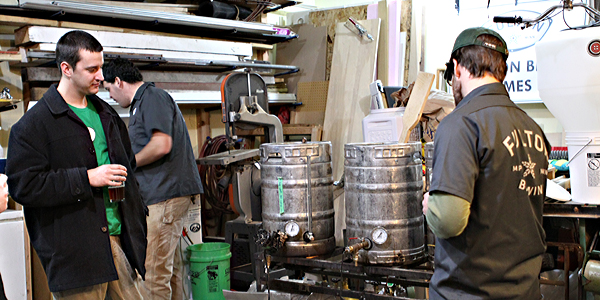
HOFFMAN: At the base of all that, too, is that we like to make beer that we like to drink, which is how it all starts when we’re doing our recipe development. We’ll work on a grain bill and play with our hop combinations, and then we’ll taste the batches and weigh out the pros and cons: “What do we like about this?” or “How can we replicate that?” So I think the reason we ended up making a more balanced IPA is because we all really like a balanced IPA.
DILEY: Right, it wasn’t about outdoing someone, or determining what the market wants. I think the market probably wants good beer.
HOFFMAN: Yeah, absolutely. It all comes down to what beer we’d like to drink, and then let’s make it.
MASTERSON: What kind of feedback are you getting with your first beer out of the gate?
DILEY: I like to run the beers we come up with by Pete’s dad. We grew up in the craft beer boom where home brewing is a big thing, and we’ve done a lot of home brewing, but he didn’t. He grew up in central Wisconsin in a resort town where you drank light beer. So if he can drink it and wants another, that’s the test, because he’s the average beer drinker. It’s funny because now that he’s starting to drink Sweet Child he’s saying, “I can’t have that light beer, I have a case of Budweiser in my fridge now and that’s a lifetime supply.” So I think when you gauge it on that, it’s overall pretty good. Yet, a lot of people that really enjoy their beer and analyze beer have come back with pretty favorable results and see the complexity that we think is in the beer.
PETZ: Yeah, in general I’d say we’re getting a real good response from the wider beer drinking community. However, some of the real beer geeks or beer snobs or whatever you want to call yourself don’t think it’s enough of an IPA for them. But you can’t please everybody.
HOFFMAN: Everyone’s palate is different.
MASTERSON: Tell me about the contract brewing experience at Sand Creek. Are you guys getting your hands dirty at the mash tun?
GRANDE: Yep, and actually, tomorrow morning at 4 am we’re heading out there to do another batch.
PETZ: They like to mash in pretty early, and it’s even earlier when you have to drive in from two and a half hours away. But it’s all been great for us because we wouldn’t have been able to do this otherwise.
Stepping back for a moment, some people kind of look down at contract brewing, and we get where that comes from. It’s obviously cooler to have your own brewery because it’s more authentic or whatever you want to call it. But the fact is we wouldn’t be here if contract brewing wasn’t there as an option. And the great thing about Sand Creek is that we called basically every brewery around, and they were the first ones that we came to that allowed us to go there and actually brew the beer. It’s a way for us to really learn on commercial equipment that we don’t actually own.
MASTERSON: So the transition from garage to commercial setting has been relatively smooth?
DILEY: Yeah, I think the beauty, as Ryan was saying, is that they’re willing to teach us what we don’t know. At the same time, the theory of brewing is applicable to whatever scale you’re doing, and in a lot of ways, in 20 years (knock on wood), when we have our own commercial brewery and we have 20 years more experience we might say something different. But the home brewer fights so many other battles in terms of consistency and developing a product and brewing it over and over again because we don’t have a clean-in-place system, and it’s not as simple as flipping one valve and cleaning out the whole thing so you’re ready for the next batch.
GRANDE: Or having a flow meter for your water…
PETZ: Right, I mean, we don’t even have running water out here in the garage right now. [laughter]
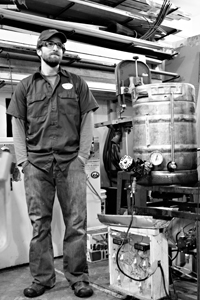
DILEY: So as home brewers moving to the commercial setting we’ve developed certain skills that we otherwise might not have because you’re always fighting those battles at home.
PETZ: And the cool thing was when we designed this system — and when I say “we” I mean Pete — we found it’s a great way to learn about brewing theory. Because every part you’re putting in, or cutting, or soldering, or welding, or hooking up, you’re wondering, “What the hell is this for?” because it’s a big pain in the ass. So once you go through all that, you really kind of get all those theories.
GRANDE: And we’ve tweaked it since. There’s still a lot of things I’d like to change about it now. I’d love to build a second system because the changes I want to make to this one would take it offline for a while. And with my five-month-old kid, the way my schedule is going, it would be offline… well, forever.
DILEY: You mean that automatic mash tun would actually be your daughter at age 14? [laughter]
MASTERSON: Are all of you taking part in the brewing when you go to Sand Creek?
PETZ: We brew by committee. Since we all have day jobs, a couple of us are going out there tomorrow, sometimes all four of us.
MASTERSON: Do you foresee the need to go to brewing school?
PETZ: Yeah, absolutely. Pete is starting to take classes from Siebel, next weekend actually. So yes, we definitely see the need. But the great thing is we’ve been able to get this far from all the standard home brewing books everyone’s read from Papazian, Palmer, and others.
DILEY: The thing is, when we homebrew in our garage, it ends up just being a Saturday, no matter what happens. But out there, in a larger commercial setting, when you’re inefficient, you’re talking about your revenue for the month. So brewing school is a great coupling of experience in home brewing, and tacking on that knowledge that’s required when you’re staring at a 30-barrel mash tun.
MASTERSON: So what are the plans for a physical space? Have you been scouting locations?
PETZ: Well, it’s kind of an ongoing brainstorm. But really it’s in Minneapolis. I guess the nice thing about contract brewing is that it affords us to slowly build, providing things continue to go well and we continue to grow and we get more beers out. We can maybe start off with a little bit bigger brewery, or not even necessarily bigger, but get some of those things that you couldn’t otherwise when you’re mortgaging everything you have and you’re pulling together every bit of investor money you can find without having ever sold a bottle of beer.
GRANDE: Contract brewing right now also allows us to decide on a system, where we know we’re selling X number of barrels a year, so here’s the size system we need and can better plan for growth.
PETZ: Yeah, so it’s another great argument for contract brewing because now we know what we like about Sand Creek and we know what things we might do differently.
DILEY: The other thing I think that’s important is just asking how do we see ourselves long term as being involved in the community? Because rather than having to debt service the building and the equipment, contract brewing allows us to do some of the other things.
[Last] weekend we [had] an event at Bryant Lake Bowl and we’re working for a food shelf. If we had to sell every single keg because we had to pay for that brewery, right now we wouldn’t be able to do those types of things. And I think, yeah, we started the brewery to brew beer and to brew great beer and hopefully have a brewery one day. But it’s also a little bit greater than that. Let’s brew great beer for the community at large, and part of that community includes organizations like a food shelf, like Project Legos.
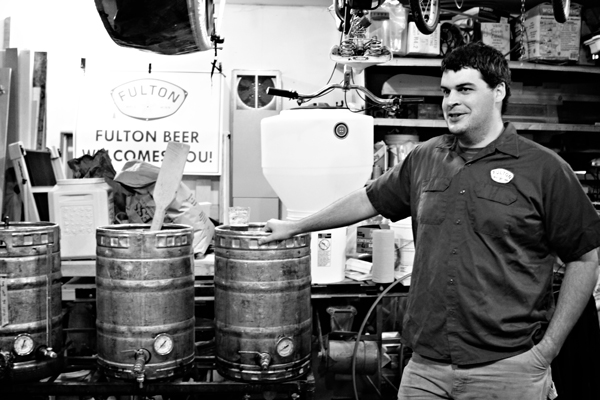
MASTERSON: Are charitable aspirations a motivation for you as a company?
HOFFMAN: It’s been part of the conversation for us the whole time through. What can we do as a company to be socially responsible? We’ve talked about programs some larger companies already do, giving 1 percent back, Patagonia, stuff like that. But it’s like, well, as a small startup company that’s not making a lot of money right now, what does that really mean for our community?
DILEY: To echo what Brian was saying, it’s the idea that we can actually be involved in the community. And not just because we’re a brewery, but because we’re people living and working here too.
MASTERSON: So how did you guys get off the ground with the necessary funding to start the company?
PETZ: Well, it took surprisingly little, which again goes back to the contract brewing setup. But again we still had to buy kegs and no matter how carefully you project, there’s always going to be little things you just don’t think of. We took out a small business loan, and we all put in a little bit of our own money. But we were fortunate in that all four of us have outside careers, so the bank was able to loan us money on personal guarantees based on our other income. But if you were starting a small business and this was going to be your sole source of income, well, the bank isn’t going to make that loan to you.
MASTERSON: This leads us to your Ful-10 program. You’re planning to invest 10 percent of your annual profits into a fund to help finance other deserving startups?
PETZ: The bank doesn’t make a loan to you based on the merits of your business plan or what you think you’re going to do in the future. They want to make absolutely sure they’re going to get their money out of it every month. That said, we think there’s a lot of great businesses out there – and we hope ours will also be great some day – that are still worthy of getting a loan of some sort. So without some form of alternative financing, without the “friends and family” money or wherever it’s going to come from, there has to be another way to help get those businesses off the ground. And that was the inspiration for our Ful-10 program.
MASTERSON: What is your timeline for a physical space?
PETZ: Well, it’s probably a couple years at a minimum. We’d like it to be as short of a timeframe as possible, but…
GRANDE: Jim faithfully buys Powerball tickets. [laughs]
DILEY: I do, and I pick up pennies off the ground. Well, I think the thing is, three years seems like such a long time, yet, the past six months have been a blur. And everyone can remember that time in their life where they realize, “What, that was three years ago?” But I think right now, if we can focus on producing good beers and being out in the community and telling people about it, three years is going to go by like that. And better yet, when it does happen, we’re not going to miss a step. We’re gonna have our beers out to the people to enjoy, and that’ll allow us to do different one-offs and other offerings we want to be doing.
I think the physical space thing is important, but to put someone on a plateau because they have physical property is not necessarily a fair comparison to me because in the end it’s about being socially responsible, and focusing on what’s in the glass.
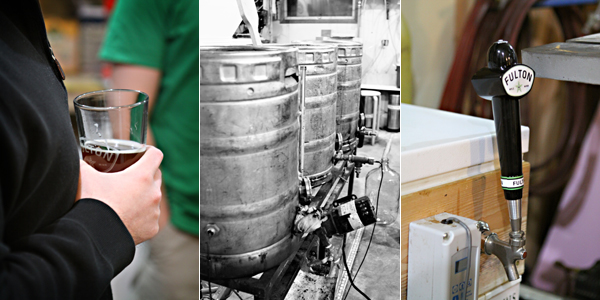
MASTERSON: What’s your take on the Twin Cities beer scene? Why start now with a brewery?
HOFFMAN: Our local scene is made up of really great beer. But if you make a comparison to what’s in Wisconsin, or California, or even Denver, we don’t have nearly as many local companies producing good beer. So I think there’s room for more great beer in the Twin Cities, but the reason we went for it now is not because we thought, “Well, here’s our moment, we can sneak in.”
We’ve actually talked to a lot of other guys from different breweries in the area, and I think what they told us is that they feel the same way we do in that it’s not really a competition, it’s more about growing the local craft beer industry. We’re not fighting against each other, we’re fighting against the light beers.
The big thing for us was that if we go for it now, failure is not an option. But in the back of our minds, if it does crash and burn in two months, we’ll all be OK and be able to finish our payments. And then 20 years from now we can look at each other and say, “Man, do you remember when we thought we could start a brewery?”
MASTERSON: What other breweries do you look to and admire? Have you gotten any support from anyone locally?
PETZ: We’ve gotten to know a couple people at Sierra Nevada, and what they do as a company, besides the fact their beer is outstanding, is they’re one of the most responsible, sustainable breweries in the world. New Belgium is another example. Also Dogfish Head and Stone.
HOFFMAN: Locally, Surly continuously pushes the limits with their beers. Their Surly Wet was just about the hoppiest thing I’ve ever tasted, and it was awesome for that reason. Lift Bridge is doing great beer, and they’re really nice guys and we’ve talked with them. Also the guys at Flat Earth, really nice and really helpful.
PETZ: Everyone we’ve called and asked questions to has been more than willing to answer them, and take the time to sit down with us in some cases, so we can thank all of them for that. And just in general, what Summit did over 20 years ago, and what Surly did starting four or five years ago, has made it possible for a brewery like us to come in right now. Wow… do you think someone will ever say, “Man, I’m glad those Fulton guys helped pave the way for us?”
DILEY: No, not if they know us. [laughs] You look at Summit and all the breweries that have sprung up in their footsteps, and it’s paving a way in a market that, yes, wants beer. But everyone knows that bar where they walk in and there’s Coors Light, and that’s not something that’s going to necessarily change, and it’s especially not going to change overnight. So you ask who we look up to, and it’s really any Minnesota brewer, because they’re hoeing that row for us and for brewers to come in the future.
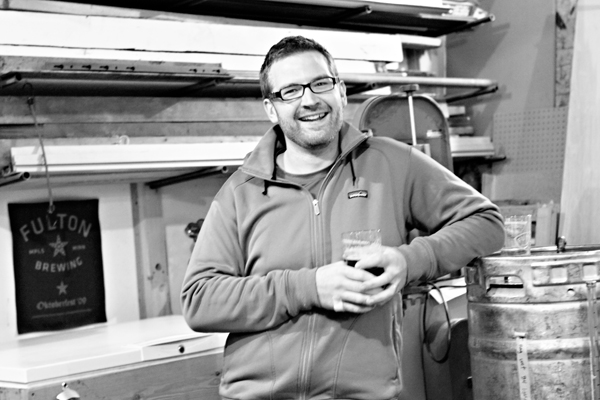
MASTERSON: What’s been the most eye opening part of this process for you guys?
DILEY: Probably the most eye opening is the fact that Ryan is not funny at three in the morning.
PETZ: Depends on what side of 3 am you’re coming from. If I’m getting up to brew I’m not very funny at all, but on New Year’s, I was hilarious.
HOFFMAN: For me, it’s all the details you would never have thought about. Just a short time ago, we were thinking we needed to go out and get some stickers as giveaways, so we called a couple sticker places and they asked us, “Well, what size do you want? What color do you want? What paper do you want? Glossy, not glossy?” And I’m just like, “Look, I want a sticker, and I want it to go on a water bottle or a bumper.” And it’s like that with many things we want to do.
MASTERSON: Five to 10 years from now where do you see Fulton?
PETZ: In the next version of “Land of Amber Waters” under the section “Breweries That Almost Made It.”
GRANDE: Or maybe “so they bought these three breweries out, they’re kicking out about 90,000 barrels…”
PETZ: In five years, we’d like to be brewing all of our beers out of Minneapolis. In 10 years we’d like to be doing the same and be all over the state and in some select markets as it makes sense. We’d really like to make beers that are approachable for people that are newer to craft beer. We’d have different lines, like our blonde example, but we’d also be breaking new ground and going into some bigger beers that are more limited release.
GRANDE: Also keeping an eye on sustainability, the bigger you get the more it can matter.
PETZ: We can take our spent grain and make bread. We’ll be the Fulton Bakery in 10 years. They’re cheaper than breweries, as it turns out.
DILEY: It’s kind of like the lofty “what would you do if you won the Powerball” kind of question… but the thing is, we all just really like hanging around and drinking beer. [Our tagline], call it lame, call it creative, is “Ordinary Guys Brewing Extraordinary Beer.”
And I think we are truly ordinary guys because we love just going into a bar and sitting down over a pint and just talking to people. So in 10 years if we can be sitting down at a patio with you talking over a beer of Fulton, that’d be great. Screw making millions, or making nothing, or conquering the craft beer industry. I would just like to be a brewer that’s in Minneapolis brewing beer for people in Minneapolis.
PETZ: That’s what it comes down to.
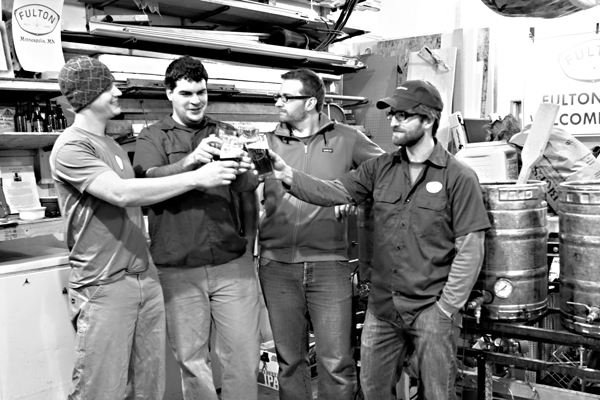
Aaron Masterson is the author of local craft beer and homebrew blog, The Captain’s Chair.

I’d like to try some of this–is there a list anywhere of where it’s available?
NJG, there is a link at the top of this article to Fulton’s website (http://www.fultonbeer.com). Go there and you’ll be able to find a list of places where the beer is available.
Great article Heavy Table! To find locations http://www.fultonbeer.com
You can get it at Stub and Herbs.
Great Article!
By the looks of things on the website, not all the beers are super-hopped with Cascade hops! That, in itself, is worthy of congratulations. I’m looking forward to trying some of these beers.
I tried one of these beers at la Grassa the other night. Quite tasty. If I’m not mistaken, it is notably higher in alcohol, so be warned!
I agree Jane, I had a couple the other day and was pleasantly surprised :) More for your dollar, is the way I look at it. Quite tasty indeed.
Great interview Heavy Table & Aaron Masterson. Enjoyed reading it, and have enjoyed their IPA on tap. Fulton is a nice addition to the Minneapolis and Twin Cities community.
Had their Sweet Child of Vine at the Muddy Pig last night. Delicious! very tasty, drinkable!
Great article! I love the beer and I look forward to seeing these guys turn out some more!
-RG
Very nice article. I would second using WordPress. It does so much more than just blogging. I built my own site with it and it was pretty simple to use. I am not that tech savvy and I figured it out. so most people should be able to figure it as well.Dallas architects recently posted..Dallas residential architect exterior photos2